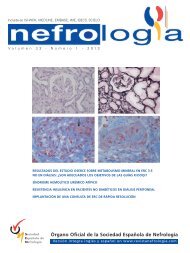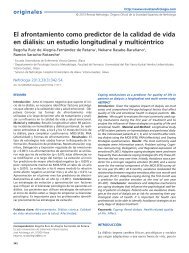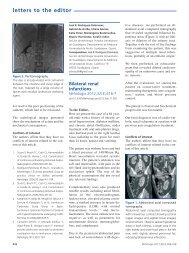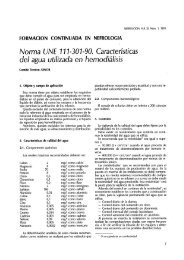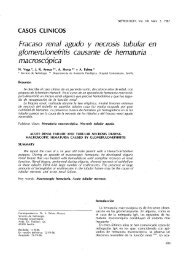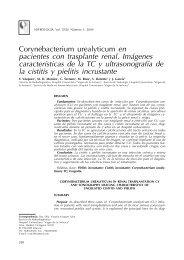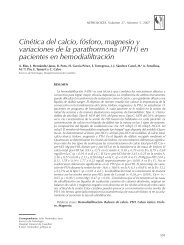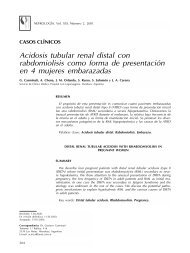PDF Número - NefrologÃa
PDF Número - NefrologÃa
PDF Número - NefrologÃa
You also want an ePaper? Increase the reach of your titles
YUMPU automatically turns print PDFs into web optimized ePapers that Google loves.
evisión corta<br />
http://www.revistanefrologia.com<br />
© 2012 Revista Nefrología. Órgano Oficial de la Sociedad Española de Nefrología<br />
Ischemic nephropathy – pathogenesis and treatment<br />
Marcin Adamczak, Andrzej Wiecek<br />
Department of Nephrology, Endocrinology and Metabolic Diseases. Medical University of Silesia, Katowice (Poland)<br />
Nefrologia 2012;32(4):432-38<br />
doi:10.3265/Nefrologia.pre2012.Apr.11472<br />
ABSTRACT<br />
In this review paper we would like to summarized the<br />
current knowledge concerning the pathogenesis and<br />
treatment of ischemic nephropathy. Epidemiological<br />
data suggest that the prevalence of ischemic<br />
nephropathy increases, especially among older<br />
individuals. The pathogenesis of this disease is more<br />
complex than just narrowing of the renal artery due to<br />
atherosclerosis. Renin-angiotension system, growth<br />
factors, different cytokines and chemokines may<br />
participate in the pathogenesis of ischemic<br />
nephropathy. Precise, clinically useful diagnostic criteria<br />
of the ischemic nephropathy have not been established,<br />
yet. Concerted medical management remains now the<br />
main therapeutic option for majority of patients with<br />
this disease and only in the selected patients<br />
revascularisation is nowadays indicated.<br />
Keywords: Ischemic nephropathy. Renal artery stenosis.<br />
Chronic kidney disease. Medical therapy. Renal<br />
angioplasty.<br />
Nefropatía isquémica: patogénesis y tratamiento<br />
RESUMEN<br />
En esta revisión nos gustaría realizar un resumen del<br />
conocimiento actual sobre la patogénesis y el tratamiento<br />
de la nefropatía isquémica. Los datos epidemiológicos<br />
sugieren que la prevalencia de la nefropatía isquémica<br />
aumenta, especialmente en los individuos de mayor edad.<br />
La patogénesis de esta enfermedad es más compleja que<br />
el mero estrechamiento de la arteria renal a causa de la<br />
ateroesclerosis. El sistema renina-angiotensina, los<br />
factores de crecimiento, las diferentes citoquinas y las<br />
quimiocinas pueden estar implicados en la patogénesis de<br />
la nefropatía isquémica. Específicamente, los criterios<br />
diagnósticos de utilidad clínica de la nefropatía isquémica<br />
aún están por determinar. La gestión médica acordada de<br />
forma conjunta sigue siendo por el momento la principal<br />
opción terapéutica para la mayoría de los pacientes con<br />
esta patología y hoy en día, la revascularización está<br />
indicada únicamente en pacientes seleccionados.<br />
Palabras clave: Nefropatía isquémica. Estenosis de la arteria<br />
renal. Enfermedad renal crónica. Tratamiento médico.<br />
Angioplastia renal.<br />
INTRODUCTION<br />
Atherosclerotic renal artery stenosis (RAS) is often one of<br />
the sign of generalized atherosclerotic disease. 1-3 Patients<br />
with atherosclerotic RAS are at a high risk of cardiovascular<br />
death. 4 Conlon et al. found in patients who underwent<br />
cardiac catheterization, that 4 years survival was 86% in<br />
those subjects without RAS and only 65% in those with<br />
RAS. 5 The degree of RAS does also significantly influence<br />
the survival. Four years survival in patients with RAS _75%<br />
Correspondence: Andrzej Wiecek<br />
Department of Nephrology,<br />
Endocrinology and Metabolic Diseases. Medical University of Silesia.<br />
Katowice. Poland.<br />
awiecek@spskm.katowice.pl<br />
narrowing survival was only 57%. 6 Johansson M. et al.<br />
observed 164 patients with RAS >50% over 7 years. 7 During<br />
this period 33 patients died and only in 2 patients the<br />
progression to stage 5 of chronic kidney disease (CKD) was<br />
observed. Risk of death in patients with RAS >50% was over<br />
3 times higher than in general population. 7 Therefore, it is<br />
important to stress that patients with ischemic nephropathy<br />
are more likely to die due to cardiovascular complications<br />
than to progress to CKD stage 5.<br />
Atherosclerotic RAS can lead to the ischemic nephropathy<br />
(ischemic renal disease). Ischemic nephropathy is defined by<br />
the gradual reduction of the glomerular filtration rate (GFR)<br />
or a loss of renal parenchyma caused by vascular occlusion,<br />
not attributable to the other causes. Therefore, the ischemic<br />
nephropathy is characterized by a reduction of blood flow to<br />
432



